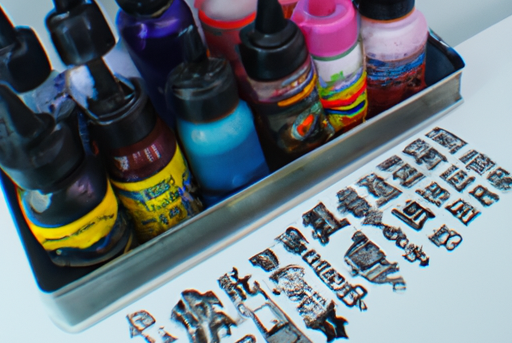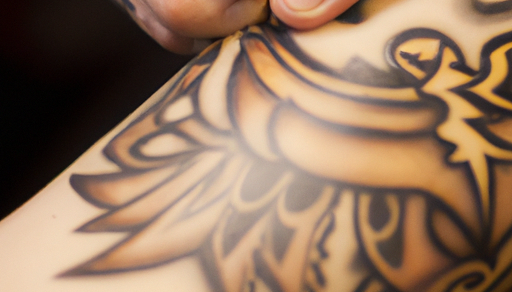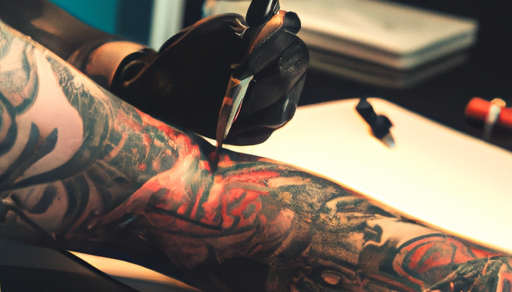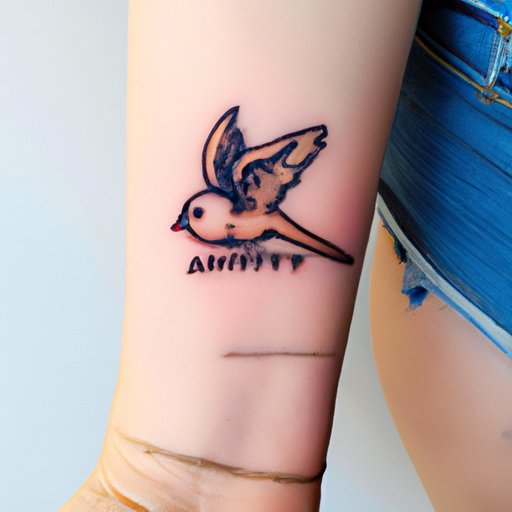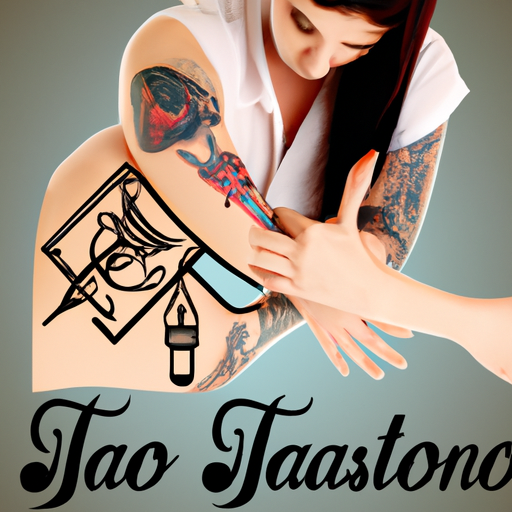Tattooing has become a popular form of self-expression, and the use of tattoo ink is a vital part of the tattooing process. Tattoo ink is an essential component of creating a tattoo. Without ink, it would be impossible to create the permanent designs that are associated with tattoos. The type of ink used in a tattoo is essential in achieving the desired effect. The color, shade, and opacity of the ink can all impact the final appearance of the tattoo.
Tattoo ink is also important because it must be safe for use on the skin. The ink must be made from high-quality, non-toxic ingredients to avoid causing any harm or allergic reactions to the person receiving the tattoo.
Furthermore, tattoo ink plays a crucial role in the longevity of a tattoo. High-quality ink, when applied correctly and maintained properly, can ensure that a tattoo looks vibrant and attractive for years to come. In contrast, low-quality ink can cause a tattoo to fade, blur, or even disappear entirely.
Importance of tattoo ink cannot be overstated. It is an integral part of the tattooing process and can impact the safety, appearance, and longevity of a tattoo. Tattoo artists and enthusiasts alike should always prioritize using high-quality ink to create and maintain tattoos that they can be proud of.
There are different types of tattoo ink, and each has its own unique properties.
In this blog post, we will discuss the different types of tattoo ink and their uses.
 Traditional tattoo ink is the most commonly used ink in tattooing. It is made from a combination of carbon black, water, and alcohol. This type of ink is known for its reliability, versatility, and longevity.
Traditional tattoo ink is the most commonly used ink in tattooing. It is made from a combination of carbon black, water, and alcohol. This type of ink is known for its reliability, versatility, and longevity.
One of the primary advantages of traditional tattoo ink is its versatility. It can be used for both outlining and shading, and it is available in different shades from light gray to dark black. This makes it an ideal choice for creating bold, intricate designs that require a range of tones and textures.
Another advantage of traditional tattoo ink is its longevity. When applied correctly and maintained properly, tattoos created with traditional ink can last a lifetime. This is because the ink is designed to be permanent and resistant to fading, even when exposed to sunlight, water, or other environmental factors.
Traditional tattoo ink is also known for its reliability. Tattoo artists have been using this type of ink for generations, and it has a proven track record of producing high-quality, long-lasting tattoos. This means that tattoo enthusiasts can have confidence in the quality and consistency of tattoos created with traditional ink.
One of the only downsides of traditional tattoo ink is that it can be challenging to remove. Unlike some other types of tattoo ink that can be faded or removed with laser treatments, tattoos created with traditional ink are generally considered to be permanent. This means that anyone considering a tattoo created with traditional ink should carefully consider the design and placement of the tattoo before committing to the procedure.
Overall, traditional tattoo ink is a tried and tested option for anyone looking to create a permanent tattoo. Its versatility, longevity, and reliability make it a popular choice among tattoo artists and enthusiasts alike. So if you’re considering getting a tattoo, traditional tattoo ink may be the perfect choice for you.
 Organic tattoo ink is a type of ink that is made from natural ingredients such as plant-based pigments, fruits, vegetables, and other natural substances. It is a popular choice for people who are looking for a more natural and eco-friendly option for their tattoos.
Organic tattoo ink is a type of ink that is made from natural ingredients such as plant-based pigments, fruits, vegetables, and other natural substances. It is a popular choice for people who are looking for a more natural and eco-friendly option for their tattoos.
One of the primary benefits of organic tattoo ink is that it is free from synthetic chemicals and other harmful ingredients. This means that it is generally considered to be safer for use on the skin, especially for people who have sensitive skin or are prone to allergies.
Organic tattoo ink is also known for its vibrant colors and unique textures. Because it is made from natural ingredients, it can produce colors and shades that are not possible with traditional tattoo ink. This means that tattoos created with organic ink can have a more natural and organic appearance, which can be especially appealing for people who are looking for a more authentic and earthy aesthetic.
Another advantage of organic tattoo ink is that it is often more environmentally friendly than traditional ink. Many organic inks are made from sustainably sourced ingredients, which means that they have a lower environmental impact than traditional inks that may be made from synthetic materials and chemicals.
However, there are some potential drawbacks to using organic tattoo ink. Because it is made from natural ingredients, it can be more challenging to work with than traditional ink. This can make it more difficult for tattoo artists to achieve the desired effect, especially when it comes to shading and blending.
Overall, organic tattoo ink is a viable option for people who are looking for a more natural and eco-friendly approach to tattooing. While it may have some limitations in terms of its application and effectiveness, it can produce stunning results and is generally considered to be a safer and more sustainable option for creating permanent tattoos.
 Glow-in-the-dark tattoo ink is a type of ink that is designed to glow under certain conditions, typically in low light or complete darkness. This type of ink has gained popularity in recent years due to its unique and eye-catching appearance.
Glow-in-the-dark tattoo ink is a type of ink that is designed to glow under certain conditions, typically in low light or complete darkness. This type of ink has gained popularity in recent years due to its unique and eye-catching appearance.
Glow-in-the-dark tattoo ink is typically made from a combination of phosphorescent pigments and a carrier solution. The phosphorescent pigments are charged by exposure to light, which causes them to emit light when they are in a dark environment.
One of the primary benefits of glow-in-the-dark tattoo ink is its ability to create stunning visual effects. When exposed to low light or complete darkness, tattoos created with this type of ink can produce an ethereal, otherworldly glow that is sure to turn heads.
 Another advantage of glow-in-the-dark tattoo ink is that it can add an extra layer of creativity and individuality to a tattoo. By incorporating glow-in-the-dark elements into a design, tattoo artists can create truly unique and memorable tattoos that stand out from the crowd.
Another advantage of glow-in-the-dark tattoo ink is that it can add an extra layer of creativity and individuality to a tattoo. By incorporating glow-in-the-dark elements into a design, tattoo artists can create truly unique and memorable tattoos that stand out from the crowd.
However, there are also some potential downsides to using glow-in-the-dark tattoo ink. First and foremost, this type of ink is often more expensive than traditional ink. Additionally, it can be more challenging to work with, as it may require multiple layers and careful application to achieve the desired effect.
There is also some concern about the safety of glow-in-the-dark tattoo ink. While this ink is generally considered to be safe for use on the skin, some experts have raised concerns about the long-term effects of exposure to phosphorescent pigments. As such, it is important to research and consult with a trusted tattoo artist before deciding to get a glow-in-the-dark tattoo.
Overall, glow-in-the-dark tattoo ink is a unique and exciting option for people looking to add an extra element of creativity and individuality to their tattoos. While it may have some potential drawbacks and safety concerns, it can produce stunning results when applied correctly and can help people express their individuality in a truly unique way.
UV tattoo ink is a type of ink that is designed to be invisible under normal light but becomes visible when exposed to ultraviolet (UV) light. This type of ink has gained popularity in recent years due to its unique and eye-catching appearance.
 UV tattoo ink is typically made from a combination of invisible ink and a carrier solution. The invisible ink contains a chemical compound that absorbs UV light and emits visible light, causing the tattoo to glow under UV light.
UV tattoo ink is typically made from a combination of invisible ink and a carrier solution. The invisible ink contains a chemical compound that absorbs UV light and emits visible light, causing the tattoo to glow under UV light.
One of the primary benefits of UV tattoo ink is its ability to create a hidden tattoo that only becomes visible under certain conditions. This can be especially appealing for people who want to have a tattoo that is not immediately visible in professional or conservative environments, but can still be shown off in social settings.
Another advantage of UV tattoo ink is that it can add an extra layer of creativity and individuality to a tattoo. By incorporating UV ink into a design, tattoo artists can create unique and visually stunning tattoos that are sure to turn heads.
However, there are also some potential downsides to using UV tattoo ink. First and foremost, this type of ink is often more expensive than traditional ink. Additionally, it can be more challenging to work with, as it may require multiple layers and careful application to achieve the desired effect.
There is also some concern about the safety of UV tattoo ink. While this ink is generally considered to be safe for use on the skin, some experts have raised concerns about the long-term effects of exposure to UV light. As such, it is important to research and consult with a trusted tattoo artist before deciding to get a UV tattoo.
Overall, UV tattoo ink is a unique and exciting option for people looking to add an extra element of creativity and individuality to their tattoos. While it may have some potential drawbacks and safety concerns, it can produce stunning results when applied correctly and can help people express their individuality in a truly unique way.
White tattoo ink is a unique and often misunderstood type of ink that is used to create tattoos that appear white or have a lighter, more subdued appearance. While white tattoo ink may seem like a straightforward concept, there are actually many different factors that can affect the way it looks and how it behaves in the skin.
One of the main benefits of white tattoo ink is its ability to create a subtle and understated look. White ink can be used to create highlights, add dimension, and soften the edges of a tattoo, giving it a more organic and natural appearance.
 Another advantage of white tattoo ink is its versatility. When used on its own, white ink can create a simple and elegant design. However, it can also be mixed with other colors to create a wide range of unique and creative effects.
Another advantage of white tattoo ink is its versatility. When used on its own, white ink can create a simple and elegant design. However, it can also be mixed with other colors to create a wide range of unique and creative effects.
However, there are also some potential downsides to using white tattoo ink. One of the main concerns is its visibility on certain skin tones. On lighter skin tones, white ink can create a subtle and beautiful effect, but on darker skin tones it may not show up as well or may appear yellowish or gray.
Additionally, there is some concern about the safety of white tattoo ink. Some formulations of white ink have been known to cause adverse reactions in the skin, such as swelling, itching, or scarring. It is important to do your research and consult with a trusted tattoo artist before deciding to get a tattoo using white ink.
Overall, white tattoo ink is a unique and creative option for people looking to add an extra layer of dimension and subtlety to their tattoos. While it may have some potential drawbacks and safety concerns, it can produce stunning results when applied correctly and can help people express their individuality in a truly unique way.
Metallic tattoo ink is a type of ink that is designed to mimic the look and feel of metallic materials, such as gold, silver, bronze, or copper. This type of ink has gained popularity in recent years due to its unique and eye-catching appearance.
Metallic tattoo ink is typically made from a combination of metallic pigments and a carrier solution. The pigments used in metallic ink are tiny metal flakes that are suspended in the carrier solution, giving the ink its signature shine and sparkle.
One of the primary benefits of metallic tattoo ink is its ability to create a truly unique and attention-grabbing tattoo design. By incorporating metallic ink into a design, tattoo artists can create tattoos that shimmer and shine in the light, giving them a three-dimensional quality that is not possible with traditional ink.
Another advantage of metallic tattoo ink is its versatility. While metallic ink is often used to create jewelry-inspired designs, it can also be used in a wide range of other tattoo styles, from traditional to abstract and everything in between.
However, there are also some potential downsides to using metallic tattoo ink. First and foremost, this type of ink can be more expensive than traditional ink, due to the higher cost of the metallic pigments used in its formulation. Additionally, metallic ink can be more challenging to work with, as it may require multiple layers and careful application to achieve the desired effect.
There is also some concern about the safety of metallic tattoo ink. While metallic ink is generally considered to be safe for use on the skin, some people may experience allergic reactions or other adverse effects. It is important to research and consult with a trusted tattoo artist before deciding to get a tattoo using metallic ink.
Overall, metallic tattoo ink is a unique and exciting option for people looking to add an extra layer of creativity and individuality to their tattoos. While it may have some potential drawbacks and safety concerns, it can produce stunning results when applied correctly and can help people express their individuality in a truly unique way.
Conclusion:
In conclusion, the type of tattoo ink used in a tattoo is essential in achieving the desired effect. The ink used should be safe for use and suitable for the individual’s skin type. Tattoo artists should also ensure that they use high-quality ink and that they follow the manufacturer’s instructions for use. By choosing the right type of tattoo ink, individuals can have a unique and beautiful tattoo that lasts a lifetime.
